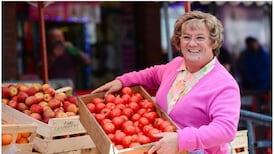The German photographer and artist David Jazay first visited Dublin as a 16-year-old exchange student in 1982. Armed with a twin-lens Rolleiflex, he wandered around the city's increasingly dilapidated Georgian buildings and the increasingly empty spaces along the quays. By 1988, when Jazay and co-director Judith Klinger came to shoot Bargaintown on 16mm, there are only remnants of that same inner-city culture.
Indeed, when one barber talks about Dublin becoming a concrete jungle, the viewer can't help but will that eventuality along at pace. It's true, there are still furniture warehouses and old-fashioned facades to be seen and savoured. But in the years before the Celtic Tiger, many of the buildings show evidence of subsidence, and many have already been demolished. Others remain, still not gentrified or improved, almost three decades later. When one mulleted local talks of the quays being torn down "to make way for shopping centres", one can't help but note the lack of such facilities in the spot where he stands.
Jazay's careful and appealing compositions illustrate that he's entirely on the level. This is not the work of a cultural tourist come to pap the city's remaining horses and carts. This is a loving curator of showband versions of I Just Called to Say I Love You at the Workman's Club. This camera loves the threadbare locals – most of whom might easily have wandered in from the 1950s – and the creatively tatty shopfronts.
There's a grim irony in hearing o in camera contributors speak of 'world recession' and 'chronic unemployment'. But this remains a lovely document, only recently restored in time for a first Irish run. The length and composition of Bargaintown suggest it would perhaps work better as an installation than a theatrical release. A fascinating record, nonetheless.
- Bargaintown is showing at the IFI in Dublin













